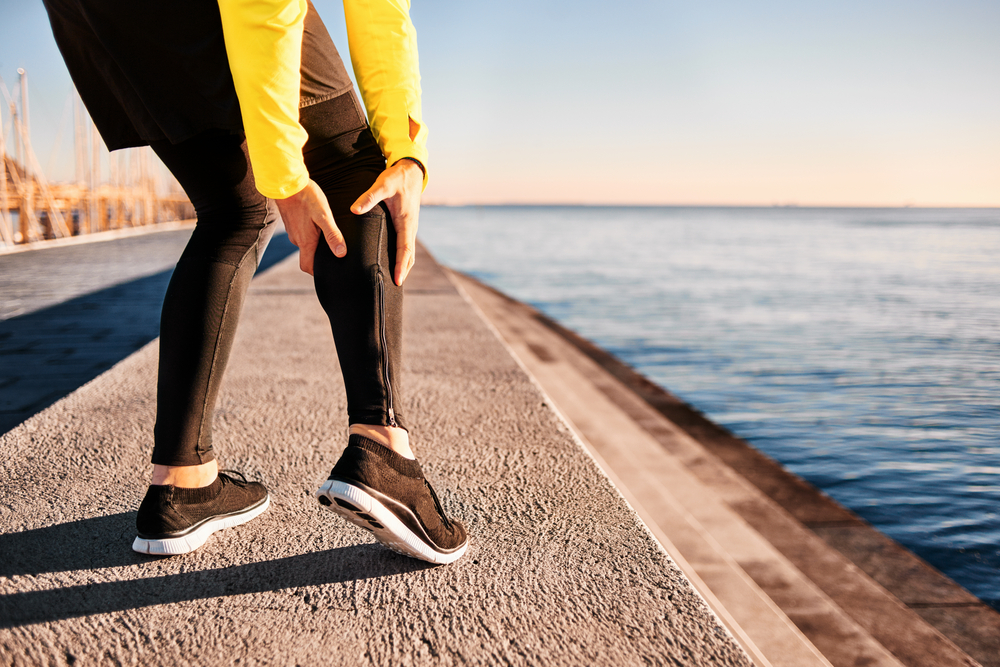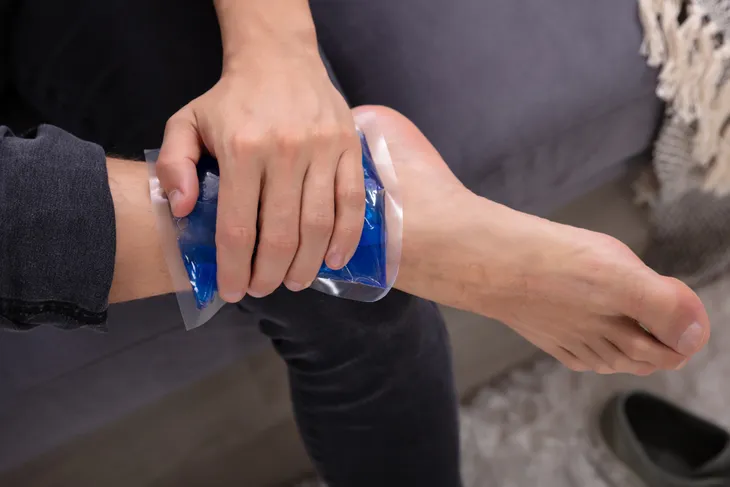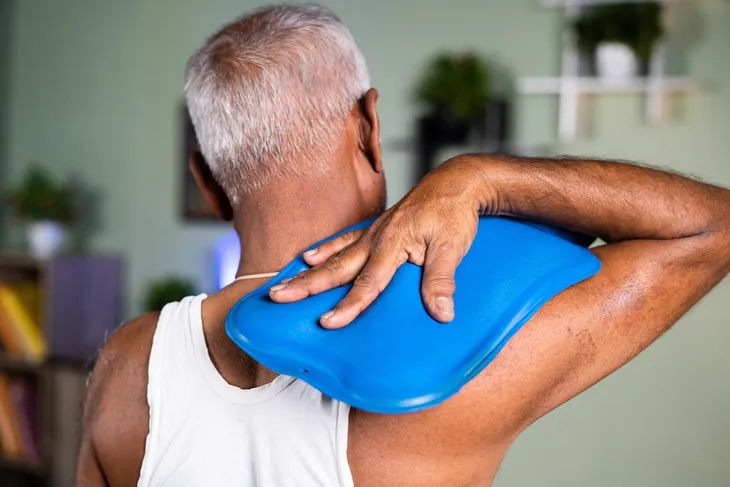- Dealing with a strained muscle is never fun. Luckily there are simple yet effective ways to help relieve and heal your pulled muscles.
- Cold and heat therapy along with rest are just a few ways to encourage healing.
- If your home remedies provide no relief within 24-hours you should see your doctor as you may have sustained a more significant injury.
A muscle pull (or strain) occurs when you twist, pull, or tear one of your muscles. As we age we are more susceptible to muscle pulls. However, you risk a pull if you don’t warm up properly before you exercise and stretch a muscle past its limit, train longer than what your body can handle, or if you push a past muscle injury too far before the muscle has had adequate time to heal.
You will know a muscle is pulled typically within 24 to 48-hours of the injury, as the area will become stiff and sore. You may also experience loss of movement and muscle spasms, and bruising or swelling will often develop around the injured muscle.
If you suffer a pulled muscle, here are effective ways to help speed the healing and soothe the pain and inflammation…
Ice
One of the first steps in treating a pulled muscle is ice therapy. Icing a muscle strain as quickly as possible will do its part to reduce swelling and to soothe the pain. Sports Medicine Oregon says “Some individuals may need just a single daily treatment while more severe sprains and strains may require multiple daily ice therapy applications.”
The source recommends applying ice for up to 20-minutes at a time. Do not exceed 20-minutes. Ice applications can be administered using an ice pack or placing ice cubes in a bag. Be sure to use a barrier such as a piece of cloth between the ice and skin to prevent skin burn.
Heat
Heat therapy may also be an effective method to help heal your pulled muscles. However, Sports Medicine Oregon points out that ice therapy should be used for the first 24 to 72-hours (without heat therapy), and then you can transition to heat therapy once the swelling has subsided. The heat will help to increase blood flow to the area, which if done too soon after an injury can increase swelling and bruising.
The source also notes that research says moist heat may be superior to dry heat when it comes to penetrating deeper tissues and dense muscle tissues such as the quadriceps. When using heat therapy, don’t exceed 104-degrees Fahrenheit in a hot tub or bath and when using a heating pad, be sure to wrap it in a piece of cloth to protect your skin.
To treat minor aches and pains, the source says you may benefit from 15 to 20-minute treatments daily, while moderate symptoms may benefit from a soak in a warm bath for 1 to 2-hours.
Soak in a Warm Bath
As we already know, heat therapy can be an effective way to help encourage healing. One notable method of heat therapy is soaking in a warm bath. The heat of the water can help reduce pain associated with the pulled muscle. It can also help relax muscles and loosen stiff joints.
Adding Epsom salts to the bathwater may provide even more benefits, however, more studies are still needed to confirm this. Nonetheless, it doesn’t hurt to try. WebMD recommends adding 1 to 2-cups of Epsom salts while the water is running to help them dissolve. The source says to soak for at least 12-minutes. Sit back and relax!
Elevate
The next step in healing a pulled muscle is to keep it elevated. Elevating a pulled muscle will help reduce inflammation to the area. It may also help reduce bruising by “making it more difficult for blood to reach the injury,” explains Medical News Today.
Just keep your injury above your heart level by propping it up on a pillow. This will encourage the body to send fluid buildup away from the injured area. The source also says experts recommend elevating the area for around 2 to 3-hours per day.
Rest
Resting a pulled muscle is highly recommended, especially for the early recovery phase, says Verywell Health. Depending on the seriousness of the muscle strain, you should rest the injured area for 1 to 5-days or until your doctor gives you the okay.
“Immobilization is not usually necessary and can be potentially harmful,” explains the source. Instead, focus on gentle movements after resting for a few days to maintain your muscle’s flexibility.
Anti-Inflammatory Medications
Over-the-counter (OTC) anti-inflammatory medications may also reduce painful symptoms and inflammation of a muscle injury. However, heed the instructions closely so you don’t take too much and damage your liver.
As with all medications, OTC anti-inflammatory medications can have side effects so it’s always important to talk to your doctor before taking a new medication. Finally, if the pain persists past a few days, talk with your doctor to find out if there are any better solutions. Anti-inflammatory prescription medications may be necessary.
Massage
In case you need another reason to book a massage, add healing a pulled muscle to the list! Massaging a pulled muscle will speed healing by stimulating blood circulation to the damaged area. Massage therapy may also help relieve acute pain.
Whether you get a massage by a professional or massage the area on your own at home, gentle movements are important so you don’t injure the area further. Keep in mind, it may be best to wait a few days after the injury before receiving a massage. Wait until the swelling has subsided and the pain has decreased.
Strengthen
Injured muscles that are prone to pulls and strains are typically weak. So it makes sense that following an injury, you should focus on healing and then strengthening the muscle before re-engaging in athletic activities.
Strengthening your muscles can make you less susceptible to injuries in the future. Keep in mind, both the injury and the rest period required to heal the injury can reduce the strength of that muscle. So, it’s important to start slow as you regain strength.
Gentle Stretching
Along with strengthening, stretching is also an effective way to help treat and prevent muscle strains. “Muscles that are stronger and more flexible are less likely to be injured,” explains Verywell Health.
Stretching an injured area can also help increase blood flow to heal your tissues. However, it is very important that you don’t overdo it. Over-stretching can re-injure the healing muscle fibers. A good rule to follow is if the stretching is painful, stop immediately and continue to rest the area. Once you don’t feel pain in that area, try stretching again.
The Importance of Warming Up and Cooling Down
A warm-up may not heal your pulled muscle per se but it’s definitely worth noting because it can help prevent an injury in the future. Warming up your muscles can help prevent injuries by loosening your joints and improving blood flow to your muscles, explains the Tri-City Medical Center. Warm-ups also make your muscles less likely to rip or tear during activity.
A proper cool down is also important as it helps regulate your blood flow and brings your heart rate and blood pressure back to normal levels, explains the source. Dedicate 10-minutes at the start of your workout to a warm-up and 10-minutes at the end to cool down.
When to See a Doctor
If your home remedies provide no relief within 24-hours you should see your doctor. You should also contact your doctor if you’ve sustained a significant muscle injury to rule out anything serious.
Furthermore, if you experience “popping” sounds with the injury, an inability to walk, significant swelling or pain, or a fever you should go to your hospital’s emergency room to have it checked out, says WebMD. It may be helpful to write a list ahead of your appointment that includes detailed information such as descriptions of your symptoms, how the injury happened, your medical history, and any questions you want to ask your doctor.
Diagnosis
For a proper diagnosis, your doctor will likely start with a physical exam and review your medical history. It’s important for your doctor to determine whether the muscle is strained or completely torn. If your muscle is completely torn you may have a much longer and more complicated recovery. For serious muscle tears, surgery may be necessary.
During the physical exam, your doctor will look at the muscle and check for swelling and tenderness. Identifying the location and intensity of your pain “can help determine the extent and nature of the damage,” says the Mayo Clinic. An ultrasound may also be necessary. They can help “distinguish among several different types of soft tissue injuries,” explains the source.
How to Prevent Pulled Muscles
Now that you’ve learned about what you can do if you have a pulled muscle, it’s important to understand what you can do to prevent it from happening again.
Oftentimes, muscle strains are caused by improper technique. When you’re at the gym it’s so important to perform your exercises with proper form to prevent injury. If you’re lifting a heavy object, don’t forget to bend at the knees. Stretching daily can also help improve your mobility and as mentioned earlier, don’t forget to warm up before exercising.
















